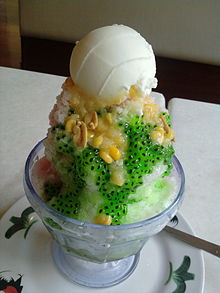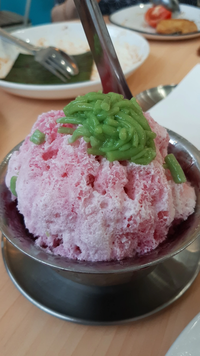Ais kacang
 | |
| Alternative names | ABC, air batu campur, ice kachang |
|---|---|
| Course | Dessert |
| Place of origin | Malaysia |
| Region or state | Southeast Asia |
| Associated cuisine | Malaysia, Singapore, Brunei |
| Created by | Malaysian Malays[2] |
| Main ingredients | Shaved ice, red beans[3] |
Ais kacang (Malay pronunciation: [aɪs ˈkatʃaŋ]; Jawi: اءيس كاچڠ), literally meaning "bean ice", also commonly known as ABC (acronym for air batu campur ([air ˈbatu tʃamˈpʊr]), meaning "mixed ice"), is a dessert which is common in Malaysia, Singapore (where it is called ice kachang) and Brunei.[1][4][5]
Traditionally, an ice shaving machine is used to churn out the shaved ice used in the dessert, originally hand cranked but now more often motorised. Many Southeast Asian coffee shops, hawker centres and food courts sell this dessert.
History
[edit]Early versions of ice kacang was first known to have been prepared around the time before and after the First World War, where the costs of ice manufacturing was becoming more affordable.[5] An earlier variant of the Singaporean dish was described as green, made from shaved ice, paired with syrups, soaked seeds and seaweed jelly and was sold mainly by street vendors. The dish underwent many different alterations and variants throughout the history of Singapore, where during the 1920s, one version of it was described as shaved ice topped with rose water, lime or liquorice. A version of the dish, known as Kachang mera, was also sold during the 1930s.[5] By the 1940s, the version of the dish described as having "shaved ice heaped into a little mountain", topped with red beans, "a Chinese grape-like fruit", syrup, and condensed or evaporated milk, similar to how it is being prepared today, began to appear.[5] Some earlier variants of ice kachang are no longer sold, such as the ice ball version of the desert, which was popular during the 1950s and 1960s[6]
Preparation
[edit]
Ais kacang was originally made of only shaved ice and red beans,[3] though the number and diversity of ingredients has since expanded.[7] Today, ais kacang generally comes in bright colors and with various fruit cocktails and dressings.
In Malaysia, variants now contain a large serving of attap chee (palm seed), red beans, sweet corn, grass jelly, roasted peanuts, and cubes of agar agar as common ingredients. Other less common ingredients include aloe vera, cendol, nata de coco, and ice cream. A final topping of evaporated milk, condensed milk, or coconut milk is drizzled over the mountain of ice along with red rose syrup and sarsi syrup.[8] Some stalls have even introduced novelty toppings such as durian[9] and chocolate syrup. There are also versions that shun the multi-coloured syrup and are served instead with just a drizzling of palm sugar syrup.
In Singapore, traditional ice kachang is usually made from shaved ice, packed into a mountain-like shape and consists of red beans, creamed corn, attap chee, cendol, and grass jelly, similar to the Malaysian version, and drizzled with syrups made from gula melaka, red rose syrup, and pandan syrup.[10] The dish has evolved to include fruits such as durian, mango, toppings such as Milo, peanuts, and sago pearls among others.[10][11]
See also
[edit]Shaved ice § Regions, for similar shaved ice variations around the world.
- Kakigōri: Japanese shaved ice
- Bingsu: Korean shaved ice
- Tshuah-ping: Taiwanese shaved ice
- Halo-halo: Filipino shaved ice
- Es campur and Es teler: Indonesian shaved ice
- Namkhaeng sai and O-aew: Thai shaved ice
- Grattachecca: Italian shaved ice popular in Rome.
- Hawaiian shave ice: Hawaiian shaved ice
- Piragua: Puerto Rican shaved ice
References
[edit]- ^ a b Sidney Mintz (2015). The Oxford Companion to Sugar and Sweets. Oxford University Press. pp. 637–. ISBN 978-0-19-931339-6.
- ^ Chris Rowthorn; Muhammad Cohen; China Williams (2008). Borneo. Ediz. Inglese. Lonely Planet. pp. 329–. ISBN 978-1-74059-105-8.
• Mat Oakley; Joshua Samuel Brown (2009). Singapore. Ediz. Inglese. Lonely Planet. pp. 204–. ISBN 978-1-74104-664-9.
• Georgeta Raţă (3 January 2013). The English of Tourism. Cambridge Scholars Publishing. pp. 168–. ISBN 978-1-4438-4486-4. - ^ a b Mat Oakley (2008). Singapore. Con cartina. Lonely Planet. pp. 60–. ISBN 978-1-74104-884-1.
- ^ Yeoh, En-lai (9 March 2012). "Down by the Boardwalk in Singapore". The Wall Street Journal. Archived from the original on 13 March 2012. Retrieved 13 March 2012.
- ^ a b c d "CULINARY BIOGRAPHIES: CHARTING SINGAPORE'S HISTORY THROUGH COOKING AND CONSUMPTION, p.26-27" (PDF). ISEAS - Yusof Ishak Institute. 1 October 2020. Archived (PDF) from the original on 25 September 2021. Retrieved 25 September 2021.
- ^ "The ice ball died in S'pore, kinda became ice kacang, & is sometimes resurrected". Mothership.SG. 24 January 2018. Archived from the original on 27 September 2021. Retrieved 27 September 2021.
- ^ Festa, Jessica (16 January 2012). "Exploring the street food in Singapore". The Huffington Post. Archived from the original on 20 March 2012. Retrieved 13 March 2012.
- ^ Simon Richmond (2007). Malaysia, Singapore & Brunei. Ediz. Inglese. Lonely Planet. pp. 75–. ISBN 978-1-74059-708-1.
- ^ Malaysia, Singapore, and Brunei. Lonely Planet Publications. 2007. ISBN 9781740597081.
- ^ a b "Ice Kachang - Singapore's Ice Cream?". Global Cook Lab. 28 September 2017. Archived from the original on 27 September 2021. Retrieved 27 September 2021.
- ^ "Liang Liang Garden Desserts – Milo Dinosaur Ice Kachang?! Sign me up!". 20 January 2020. Archived from the original on 27 September 2021. Retrieved 27 September 2021.
